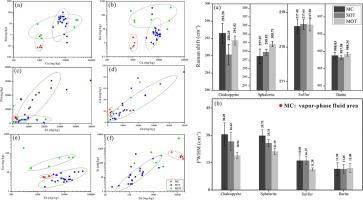Ore Geology Reviews ( IF 3.2 ) Pub Date : 2021-09-23 , DOI: 10.1016/j.oregeorev.2021.104496 Liang Ma 1, 2, 3 , Shichuan Xi 1, 2, 3 , Xin Zhang 1, 2, 3 , Zhendong Luan 1, 3 , Zengfeng Du 1 , Lianfu Li 1 , Jun Yan 1, 3

|
Inverted lakes filled with shimmering water are unique environments within hydrothermal systems. Recently, vapor-phase fluids have been detected on the top of an inverted lake in a mushroom cap-shaped (MC) sulfide structure based on in situ Raman spectra at the Yokosuka Site in the Okinawa Trough (OT). However, the effects of vapor-phase fluids on the migration and metallogenic characteristics of elements remain unclear. To characterize the influence of such fluids, a comparative study of the micro-Raman spectroscopy, electron microprobe analyses (EMPA), polarizing microscopic, element distribution, and S-Pb isotopic composition among the hydrothermal sulfides collected from MC area, the middle Okinawa Trough (MOT) and southern Okinawa Trough (SOT), was conducted. Raman spectra show that the dominant band of chalcopyrite in MC sulfide generated a blue shift, while sphalerite generated a red shift, indicating that compositional differences exist in MC sulfide samples compared to the other two areas. This was also confirmed by EMPA data for these two minerals. Moreover, the full width(s) at half maximum (FWHM) of the Raman spectra of minerals in the MC sulfide samples showed a lower degree of crystallinity influence by the vapor-phase fluids. Elemental analyses further demonstrated that the MC samples share a particular elemental composition. That is, MC sulfides featured high Mn, Ba, and Sr and low Fe, Cu, Zn, Pb, Bi, Mo, Cd, and Ga. The same enrichment trends were observed among Ba–Sr, Cu–Mo, Cu–Bi, Zn–Pb, Zn–Cd, and Zn–Ga. Moreover, the δ34S of 5.44–5.85‰ in these deposits suggest that S was contributed by the underlying basalt, sediments, and seawater. The Pb isotopic composition of MC sulfides exhibited the same compositional patterns as the other sulfides and the underlying sediments at the SOT site, indicating that the sedimentary contribution of Pb has increased. The S–Pb isotopic composition suggests that a hydrothermal source may not serve as the primary cause of differences in the MC deposits. Instead, the unique vapor-phase fluids and other gaseous components may have predominantly affected the precipitation and migration of elements at this site. Although the shimmering water regions of inverted lakes accompanied by vapor-phase fluids are difficult to observe in deep-sea hydrothermal systems, here, we describe the geochemical characteristics of sulfides affected by this particular vapor-phase fluid, providing a unique perspective on the migration and precipitation occurring during sulfide deposit formation.
中文翻译:

汽相流体对冲绳海槽南部波光粼粼的水中热液硫化物地球化学特征的影响
充满波光粼粼的水的倒置湖泊是热液系统中的独特环境。最近,基于冲绳海槽 (OT) 横须贺遗址的原位拉曼光谱,在蘑菇帽状 (MC) 硫化物结构的倒置湖顶部检测到气相流体。然而,气相流体对元素运移和成矿特征的影响尚不清楚。为了表征此类流体的影响,对从冲绳海槽中部 MC 区采集的热液硫化物的显微拉曼光谱、电子探针分析 (EMPA)、偏振显微、元素分布和 S-Pb 同位素组成进行了比较研究(MOT) 和冲绳南部海槽 (SOT),进行了。拉曼光谱表明,MC硫化物中黄铜矿的主导带产生蓝移,而闪锌矿产生红移,表明与其他两个区域相比,MC硫化物样品中存在成分差异。这两种矿物的 EMPA 数据也证实了这一点。此外,MC 硫化物样品中矿物的拉曼光谱的半峰全宽 (FWHM) 显示气相流体对结晶度的影响程度较低。元素分析进一步表明,MC 样品具有特定的元素组成。也就是说,MC 硫化物具有高 Mn、Ba 和 Sr 和低 Fe、Cu、Zn、Pb、Bi、Mo、Cd 和 Ga。在 Ba-Sr、Cu-Mo、Cu-Bi 中观察到相同的富集趋势、Zn-Pb、Zn-Cd 和 Zn-Ga。此外,δ 表明与其他两个区域相比,MC 硫化物样品中存在成分差异。这两种矿物的 EMPA 数据也证实了这一点。此外,MC 硫化物样品中矿物的拉曼光谱的半峰全宽 (FWHM) 显示气相流体对结晶度的影响程度较低。元素分析进一步表明,MC 样品具有特定的元素组成。也就是说,MC 硫化物具有高 Mn、Ba 和 Sr 和低 Fe、Cu、Zn、Pb、Bi、Mo、Cd 和 Ga。在 Ba-Sr、Cu-Mo、Cu-Bi 中观察到相同的富集趋势、Zn-Pb、Zn-Cd 和 Zn-Ga。此外,δ 表明与其他两个区域相比,MC 硫化物样品中存在成分差异。这两种矿物的 EMPA 数据也证实了这一点。此外,MC 硫化物样品中矿物的拉曼光谱的半峰全宽 (FWHM) 显示气相流体对结晶度的影响程度较低。元素分析进一步表明,MC 样品具有特定的元素组成。也就是说,MC 硫化物具有高 Mn、Ba 和 Sr 和低 Fe、Cu、Zn、Pb、Bi、Mo、Cd 和 Ga。在 Ba-Sr、Cu-Mo、Cu-Bi 中观察到相同的富集趋势、Zn-Pb、Zn-Cd 和 Zn-Ga。此外,δ MC 硫化物样品中矿物的拉曼光谱的半峰全宽 (FWHM) 显示气相流体对结晶度的影响程度较低。元素分析进一步表明,MC 样品具有特定的元素组成。也就是说,MC 硫化物具有高 Mn、Ba 和 Sr 和低 Fe、Cu、Zn、Pb、Bi、Mo、Cd 和 Ga。在 Ba-Sr、Cu-Mo、Cu-Bi 中观察到相同的富集趋势、Zn-Pb、Zn-Cd 和 Zn-Ga。此外,δ MC 硫化物样品中矿物的拉曼光谱的半峰全宽 (FWHM) 显示气相流体对结晶度的影响程度较低。元素分析进一步表明,MC 样品具有特定的元素组成。也就是说,MC 硫化物具有高 Mn、Ba 和 Sr 和低 Fe、Cu、Zn、Pb、Bi、Mo、Cd 和 Ga。在 Ba-Sr、Cu-Mo、Cu-Bi 中观察到相同的富集趋势、Zn-Pb、Zn-Cd 和 Zn-Ga。此外,δ Cu-Mo、Cu-Bi、Zn-Pb、Zn-Cd 和 Zn-Ga。此外,δ Cu-Mo、Cu-Bi、Zn-Pb、Zn-Cd 和 Zn-Ga。此外,δ34这些沉积物中的 S 为 5.44–5.85‰,表明 S 是由下伏的玄武岩、沉积物和海水贡献的。MC 硫化物的 Pb 同位素组成与 SOT 站点的其他硫化物和下伏沉积物表现出相同的组成模式,表明 Pb 的沉积贡献有所增加。S-Pb 同位素组成表明热液来源可能不是造成 MC 沉积物差异的主要原因。相反,独特的气相流体和其他气态成分可能主要影响了该地点元素的沉淀和迁移。虽然在深海热液系统中很难观察到伴随着汽相流体的倒置湖的波光粼粼的水区,但在这里,











































 京公网安备 11010802027423号
京公网安备 11010802027423号